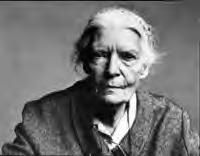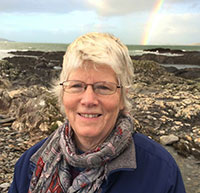 DayCHARLOTTE — Fierce. Heroic. Provocative. Pious. Granny.
DayCHARLOTTE — Fierce. Heroic. Provocative. Pious. Granny.
These are just some of the words Kate Hennessy uses to describe her late grandmother, Dorothy Day – Catholic activist, journalist and Catholic Worker Movement co-founder.
Hennessy delivered St. Peter Parish’s 23rd annual Kennedy Lecture Jan. 28, speaking via Zoom from her home in Ireland to an audience of over 120 people. She shared personal memories of growing up with Day, working alongside her and other family members at the Catholic Worker farm in upstate New York and the Catholic Worker house in New York City.
Day died in 1980, when Hennessy was 20, yet her grandmother’s Catholic witness remains alive.
“When you encountered Dorothy Day, you spent the rest of your life wondering what just hit you,” Hennessy said.
“She was so powerful,” Hennessy recalled, but not in a political sense. “Her power really was the power of presence, it’s the power of authenticity. What you saw was who she was.”
Day stood nearly 6 feet tall, with piercing blue eyes and a no-nonsense attitude, Hennessy said.
“She was provocative, she could really challenge people,” Hennessy said, listing what she calls the “Nine Provocations of Dorothy Day.”
“If she’s not scaring the bejeezus out of you, then you’re not listening to her.”
DAY’S CONVERSION AND VOCATION
Day converted to Catholicism shortly after the birth of her daughter Tamar, Hennessy’s mother.
Day had grown up nominally Christian and became an Episcopalian as a teenager, but as a young adult lived a bohemian lifestyle and became a radical activist – campaigning for women’s suffrage and against World War I, befriending anarchists and communists, going on hunger strikes and being thrown into jail.
Then in her 20s, Day had a “physically brutal” abortion in a futile attempt to save a relationship, and she feared she was sterile.
So Day saw this new pregnancy as a miracle and didn’t want to squander it, Hennessy said. “She wanted to live a life that was full of meaning, that was sacramental.”
While pregnant, Day began exploring Catholicism and attending Mass. Tamar was born in 1926, and the next year she had Tamar baptized. Day followed suit in 1928.
Day’s newfound Catholic faith and the teachings of Jesus became the anchor of her life’s work.
That work included opening soup kitchens and farms in New York to feed the growing number of poor during the Depression, protesting wars, lambasting Nazism and antisemitism, marching for civil rights with Dr. Martin Luther King Jr., picketing for farm workers’ rights with Cesar Chavez, and opposing nuclear weapons. She also kept up a furious pace of writing.
“Prayer, the sacraments and the works of mercy fueled her,” Hennessy said.
DAY AND SAINTHOOD
After the U.S. bishops’ enthusiastic endorsement in 2012, the Vatican is considering Day for sainthood. Pope Benedict XVI has cited her as “a model of conversion,” and Pope Francis has praised her “passion for justice.”
Day herself disdained being called a saint, famously remarking, “Do not call me a saint. I don’t want to be dismissed so easily.”
Hennessy said Day adored the saints, especially St. Therese of Lisieux and St. Teresa of Avila. But being labeled a saint puts someone on a pedestal – out of reach and avoidable.
“Don’t put me up there and walk away,” Hennessy said Day would insist. “For us to honor her, we cannot dismiss her. We really have to be brave. We have to look inwards: who are we and what is our work?”
DAY, BEAUTY AND LOVE
 HennessyDay introduced Hennessy to one of her favorite writers, Fyodor Dostoevsky. Dostoevsky’s words “the world will be saved by beauty” was one of Day’s favorite quotes, and Hennessy made it the title of her 2017 biography of Day.
HennessyDay introduced Hennessy to one of her favorite writers, Fyodor Dostoevsky. Dostoevsky’s words “the world will be saved by beauty” was one of Day’s favorite quotes, and Hennessy made it the title of her 2017 biography of Day.
Day loved literature, art and music, especially opera, Hennessy said, with a childlike joy. Even in her work amid dire poverty and injustice, “Granny had a very heightened sense of finding beauty wherever she could.”
“Beauty is the language of God, it is the language of Love, it is what opens our hearts,” Hennessy said. “When we open our hearts to it – when we allow it in fully, without protecting ourselves – we will be transformed.”
Day was called – and calls us – “to see people as they really are, as God sees them.”
“We are saved by beauty every day, but we’re just not paying attention,” Hennessy said.
“This way of perceiving the world fully engaged – not judgmental, not rejecting – this was something my grandmother was able to do, even up to her death.”
Asked how people should view her lasting legacy, Hennessy said Day would reply, “Stop it. Look to yourselves. Do the work.”
“Respond to the need at hand,” Hennessy said. “One of her favorite questions was: ‘What can we do in the here and now?’” – especially in the face of seemingly insurmountable problems.
Visit people in prisons, hospitals and migrant labor camps. Feed the hungry, house the homeless, clothe the naked, Hennessy said. “Find what moves you.”
— Patricia L. Guilfoyle
More online
At www.stpeterscatholic.org/kennedy-lecture: Watch the recorded 2023 Kennedy Lecture, hosted by St. Peter Parish and sponsored by Thomas and Richard Kennedy in memory of their parents, Keith and Joan Kennedy
The Nine Provocations of Dorothy Day
1. Make yourself deeply uncomfortable.
2. Follow your conscience. Listen to that still, small voice within.
3. Find your vocation. You will know your vocation by the joy it brings you.
4. Face your fears.
5. Make friends with failure. We all fail, but we have to persevere.
Perseverance is one of the greatest virtues.
6. Open yourself up to beauty. Let it transform you.
7. Don’t do it alone. Create a community through love.
8. Take delight in the humorous. Laugh at yourself.
9. Pray – abundantly, extravagantly, and in any way you can.


